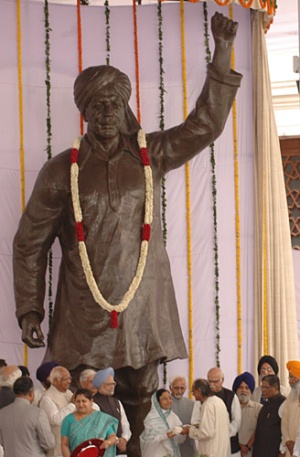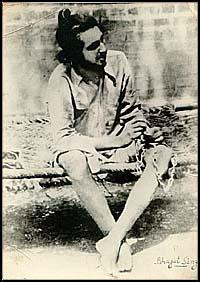Bhagat Singh’s statue in Indian Parliament: Difference between revisions
Allenwalla (talk | contribs) m (rewworked page adding other details) |
Hari singh (talk | contribs) No edit summary |
||
| Line 1: | Line 1: | ||
[[Image:Bhagat singh.jpg|thumb|right| | [[Image:Bhagat singh.jpg|thumb|right|300px|[[Shaheed Bhagat Singh|Shaheed Bhagat Singh’s]]''' statue stands outside Parliament House, Delhi, India.]] | ||
'''August 15, 2008''' | '''August 15, 2008''' | ||
'''Shaheed Bhagat Singh’s''' | '''[[Shaheed Bhagat Singh|Shaheed Bhagat Singh’s]]''' statue proudly stands just outside Parliament House in courtyard number 5. | ||
Its been nearly 80 years since Bhagat Singh dropped a bomb onto the floor of Parliament House's Central Assembly Hall to “make the deaf hear.” Today, to celebrate India's day of | Its been nearly 80 years since Bhagat Singh dropped a bomb onto the floor of Parliament House's Central Assembly Hall to “make the deaf hear.” Today, to celebrate India's day of Independence, a cause to which Bhagat Singh had dedicated his life, the larger than life statue (18 feet high) was unveiled by President Pratibha Patil, to a long deserved welcome. | ||
Relatives of the Martyr, his nephews Kiranjit Singh, Abhay Sandhu, Zorawar Singh and his niece Verinder Sandhu, were the special guests for the day, as many of the country's top leaders gathered to honor the freedom fighter, including Vice President Hamid Ansari, Prime Minister Manmohan Singh, the Lok Sabha Speaker Somnath Chatterjee, UPA Chairperson Sonia Gandhi and Leader of the Opposition L K Advani and some Union Ministers and MPs. | Relatives of the Martyr, his nephews Kiranjit Singh, Abhay Sandhu, Zorawar Singh and his niece Verinder Sandhu, were the special guests for the day, as many of the country's top leaders gathered to honor the freedom fighter, including Vice President Hamid Ansari, Prime Minister Manmohan Singh, the Lok Sabha Speaker Somnath Chatterjee, UPA Chairperson Sonia Gandhi and Leader of the Opposition L K Advani and some Union Ministers and MPs. | ||
The | The statue of the Sikh [[Shaheed]] (martyr) surprised some as the photo and film images depicting him, now famous around the world, have never depicted him wearing a [[turban]]. Well known as an atheist and a communist he made his escape sporting a well trimmed moustache and a western hat, but the lesser known story, is that during the last months of his life he had taken [[Pahul]], the Khalsa initiation, and started growing his [[kesh]] (hair). In fact the last picture of him taken in prison shortly before his death reminds one of the paintings of [[Bhai Mani Singh|Bhai Mani Singh Shaheed]] who with his turban removed is shown with the same [[Jura|top knot]], in which Sikhs traditionally tie their hair, before wrapping their turban. | ||
Some in the | Some in the media jumped at the chance to cause some controversy suggesting that the martyr should have been shown with a hat instead of a [[turban]] as he was universally known for his European hat and moustache. Among those who led this line of thought was Jagmohan Singh, a nephew of the martyr. | ||
[[Image:jailbhagat.jpg|thumb|300px|left|Bhagat Singh|Only one camera photograph of Bhagat Singh is available. It was taken in Lahore jail. Other pictures are all imaginary. The above is a painting based on the real camera photograph]] | |||
The | The Communist Party of India-Marxist (CPM) was notably absent on the day that many thought should have come many years before. Kiranjit Singh, son of the Bhagat’s brother Kultar Singh said: | ||
:''“This, for us, is a historic moment that marks a grand repetition of history after 80 years when Bhagat Singh first entered Parliament. We would have loved to see this day arrive earlier than 61 years of freedom. But that does not take away from it the happiness we feel. We were, however, hoping to see CPM MPs around. They were part of the movement that ensured Bhagat Singh his rightful place in the Parliament.”'' (Quote thanks to Punjab Heritage News) | |||
The Bhagat's niece Verinder gave a special thanks to sports minister M.S. Gill for his work in having the statue become a reality. It was Gill who first proposed the statue to celebrate the 100th birthday of [[Shaheed Bhagat Singh|Bhagat Singh]]. Gill also fought to ensure that the statue would include a turban instead of the hat, which he only donned twice in his life as a disguise. | |||
:''“Today I feel seven feet tall. For me, this is much more than winning an Olympic gold. Bhagat Singh is special to the youth of India, and he lives in each one of our hearts,”'' Gill said. (Quote thanks to Punjab Heritage News) | |||
The statue was donated by the Lok Sabha Secretariat although the Government of Panjab had offered to pay all expenses. | The statue, was sculpted by the renowned artist Ram V Sutar, who earlier sculpted the Mahatma Gandhi statue (in front of Parliament House gate No. 1) and the Ranjit Singh statue (in [[Amritsar|Amritsar’s]] Ram Bagh). The statue now shares space in courtyard no. 5 with those of Indira Gandhi and another fighter for India's freedom, Subhash Chandra Bose a contemporary of Bhagat Singh's father and more famous uncle who were role models for the young Bhagat. | ||
The statue was donated by the Lok Sabha Secretariat although the Government of Panjab had offered to pay all expenses. The Lok Sabha Secretariat has donated funds for only three other statues, those of Aurbindo Ghosh, Rabindra Nath Tagore and Vivekananda. | |||
==See also== | |||
* [[Shaheed Bhagat Singh]] | |||
* [[Bhagat Singh Gallery]] | |||
* [[Udham Singh]] | |||
[[Category: Sikh Martyrs]] | |||
Revision as of 16:39, 28 August 2008

August 15, 2008
Shaheed Bhagat Singh’s statue proudly stands just outside Parliament House in courtyard number 5.
Its been nearly 80 years since Bhagat Singh dropped a bomb onto the floor of Parliament House's Central Assembly Hall to “make the deaf hear.” Today, to celebrate India's day of Independence, a cause to which Bhagat Singh had dedicated his life, the larger than life statue (18 feet high) was unveiled by President Pratibha Patil, to a long deserved welcome.
Relatives of the Martyr, his nephews Kiranjit Singh, Abhay Sandhu, Zorawar Singh and his niece Verinder Sandhu, were the special guests for the day, as many of the country's top leaders gathered to honor the freedom fighter, including Vice President Hamid Ansari, Prime Minister Manmohan Singh, the Lok Sabha Speaker Somnath Chatterjee, UPA Chairperson Sonia Gandhi and Leader of the Opposition L K Advani and some Union Ministers and MPs.
The statue of the Sikh Shaheed (martyr) surprised some as the photo and film images depicting him, now famous around the world, have never depicted him wearing a turban. Well known as an atheist and a communist he made his escape sporting a well trimmed moustache and a western hat, but the lesser known story, is that during the last months of his life he had taken Pahul, the Khalsa initiation, and started growing his kesh (hair). In fact the last picture of him taken in prison shortly before his death reminds one of the paintings of Bhai Mani Singh Shaheed who with his turban removed is shown with the same top knot, in which Sikhs traditionally tie their hair, before wrapping their turban.
Some in the media jumped at the chance to cause some controversy suggesting that the martyr should have been shown with a hat instead of a turban as he was universally known for his European hat and moustache. Among those who led this line of thought was Jagmohan Singh, a nephew of the martyr.
The Communist Party of India-Marxist (CPM) was notably absent on the day that many thought should have come many years before. Kiranjit Singh, son of the Bhagat’s brother Kultar Singh said:
- “This, for us, is a historic moment that marks a grand repetition of history after 80 years when Bhagat Singh first entered Parliament. We would have loved to see this day arrive earlier than 61 years of freedom. But that does not take away from it the happiness we feel. We were, however, hoping to see CPM MPs around. They were part of the movement that ensured Bhagat Singh his rightful place in the Parliament.” (Quote thanks to Punjab Heritage News)
The Bhagat's niece Verinder gave a special thanks to sports minister M.S. Gill for his work in having the statue become a reality. It was Gill who first proposed the statue to celebrate the 100th birthday of Bhagat Singh. Gill also fought to ensure that the statue would include a turban instead of the hat, which he only donned twice in his life as a disguise.
- “Today I feel seven feet tall. For me, this is much more than winning an Olympic gold. Bhagat Singh is special to the youth of India, and he lives in each one of our hearts,” Gill said. (Quote thanks to Punjab Heritage News)
The statue, was sculpted by the renowned artist Ram V Sutar, who earlier sculpted the Mahatma Gandhi statue (in front of Parliament House gate No. 1) and the Ranjit Singh statue (in Amritsar’s Ram Bagh). The statue now shares space in courtyard no. 5 with those of Indira Gandhi and another fighter for India's freedom, Subhash Chandra Bose a contemporary of Bhagat Singh's father and more famous uncle who were role models for the young Bhagat.
The statue was donated by the Lok Sabha Secretariat although the Government of Panjab had offered to pay all expenses. The Lok Sabha Secretariat has donated funds for only three other statues, those of Aurbindo Ghosh, Rabindra Nath Tagore and Vivekananda.

